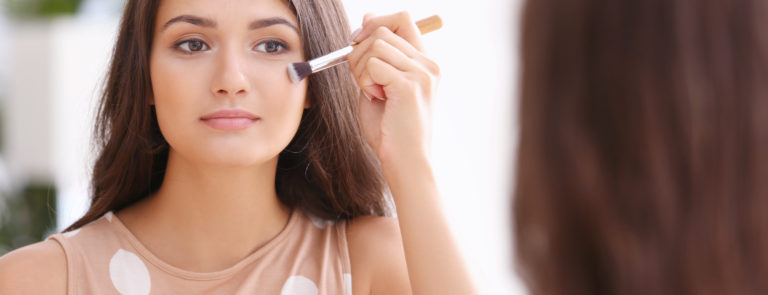15% off €25
Code:SPEND
How to dermaplane at home

Considering dermaplaning to help make your face smoother and brighter? Find out how to dermaplane at home as well as it's benefits and who should avoid it.
Summary
1Is dermaplaning the same as dermablading?
Yes, it is, dermablading just happens to be a different name for dermaplaning. However, dermaplaning isn’t to be confused with microdermabrasion...
2Is dermaplaning good or bad for skin?
The benefits of dermaplaning are widely reported and range from smoother skin and a brighter complexion, to even skin tone and increased skin cell...
3How to dermaplane at home
It’s easy to dermaplane at home. The main difference between professional and at-home dermaplaning is that professional dermaplaning involves using...
If you’re after a cutting-edge beauty treatment that will make your face look smoother and brighter, why not consider dermaplaning? If you’ve never heard of this term before, or you have and you’re curious about the benefits, read on.
What is dermaplaning?
Wondering what on earth dermaplaning is? Put simply, it’s just a fancy name for shaving the dead skin layer of your face. It’s a popular treatment at a lot of salons and spas, and it supposedly helps to exfoliate the skin and remove any dead skin cells, as well as any unwanted oil or excess hair from your face.
If you’d rather save some money or you’re a big fan of DIY beauty, it’s possible to dermaplane at home, too, you know. Before you get your razor out though, there are a few things you ought to know about this technique first.
Is dermaplaning the same as dermablading?
Yes, it is, dermablading just happens to be a different name for dermaplaning. However, dermaplaning isn’t to be confused with microdermabrasion, which is completely different.1
Whereas dermaplaning involves using a sterile blade to gently scrape dead facial skin cells and peach fuzz hair away, microdermabrasion and other exfoliation techniques involve chemical products, suction or crystals to carry out the treatments.
Summary
- Dermaplaning involves shaving dead skin and peach fuzz hair from your face
- It’s carried out by professionals with professional standard blades or you can do it at home
- Dermaplaning and dermablading are the same thing
Is dermaplaning good for us?
It’s good in the sense that most people’s skin is instantly glowing and smooth after a dermaplaning session. It can also help even out skin without having to rely on chemical exfoliants that can be aggravating.2
Dermaplaning is something most of us can have done, even if you have sensitive or chronically dry skin and want to get rid of dead skin cells without irritating your skin any further. What’s more, fresh, dermaplaned skin is more effective at absorbing products, is great for flawless makeup application and helps skin cells regenerate faster, which helps stimulate collagen production.
Handpicked content: The benefits of collagen for your skin
What are the disadvantages of dermaplaning?
If it’s not carried properly, it is possible for dermaplaning to potentially cause scarring. And if you remove hair that isn’t vellus (i.e. the peach fuzz hair) it can possibly lead to thicker hair regrowth.3
Is shaving your face the same as dermaplaning?
Not exactly. Yes, it does involve shaving hair from your face, but unlike traditional shaving, dermaplaning uses a smaller blade to remove dead skin cells and fine facial hair.4
Is dermaplaning good or bad for skin?
The benefits of dermaplaning are widely reported and range from smoother skin and a brighter complexion, to even skin tone and increased skin cell regeneration (we’ve listed some more benefits immediately below). It’s one of those treatments that’s suitable for most skin types, with the exception of people with extremely sensitive skin or thick facial hair or skin issues, such as acne or rosacea, which can be aggravated and spread as a result of dermaplaning.5
As for the downsides of dermaplaning, there don’t appear to be that many, apart from the fact your skin may look a little red immediately afterwards. It’s also best to avoid wearing any makeup for the rest of the day, as your skin barrier will be open and may be more prone to becoming irritated.

Summary
- Dermaplaning can instantly lead to glowing and smooth skin. It can also help even out skin without having to rely on chemical exfoliants that can be aggravating
- If it’s not carried properly, it may potentially cause scarring
- It’s a beauty treatment that’s suitable for most skin types
5 benefits of dermaplaning
There’s a reason why so many women choose dermaplaning. Beyond making your skin look more luminous, possible benefits include the fact:6
A build-up of dead skin cells and sebum (oil) on our face is one of the primary causes of acne. By shaving off the top layer of skin, you’ll be cleaning out your pores and potentially making your face much less prone to spots and blackheads.
Handpicked content: 9 ways to manage clogged pores and congested skin
For the same reason that dermaplaning is good for cleaning out your pores, it’s also thought to minimise the appearance of things like wrinkles, pockmarks and any acne scars you might have.
Why? Shaving off the dead skin layer smooths out the surface of your face and should make it look more radiant. Consequently, dermaplaning is a particularly popular option for those with mature skin.
It’s not just men who see hair growing on their faces! Many women also see the occasional bit of fuzz, and dermaplaning is considered to be a great way of eliminating it. You’ll have to dermaplane regularly to see lasting results, as it typically takes around three weeks for hair to grow back.
Unlike a lot of beauty procedures that aim to improve the appearance of your skin, dermaplaning has zero recovery time. Once you’ve finished, you can simply apply a soothing and gentle serum or moisturiser and then get on with the rest of your day as normal!
Note – avoid touching your face and applying make-up right away, as your pores will be wide open and more susceptible to clogging and irritation.
Contrary to popular belief, dermaplaning the hair on your face won’t make it grow back any thicker or darker. The hair follicles in your face remain completely unchanged, so you should see new hair that looks the same as it did originally.7
- The benefits of dermaplaning are widespread
- They include removing dead skin cells and oil build-up
- Your hair isn’t going to grow back thicker afterwards either
What tools are needed for dermaplaning?
If you’re planning on dermaplaning at home, all you need is a specialised dermaplane tool, which looks like a scalpel and features just one derma blade.
Is dermaplaning at home safe?
Yes, providing you use a proper dermaplaning tool and are clear on the process to follow. To help, we’ve listed how to dermaplane step by step below.

How to dermaplane at home
It’s easy to dermaplane at home. The main difference between professional and at-home dermaplaning is that professional dermaplaning involves using a surgical blade, that can’t be purchased on the High Street, and provides a deeper level of exfoliation.
Step by step guide to dermaplaning at home:
- Prepare by cleansing your face and patting it dry with a towel. You should also thoroughly clean your dermaplane blade and double cleanse if you need to.
- Start on one side of your face and hold your skin taut with one hand.
- Using the other hand, hold the dermaplaning tool at a 45-degree angle and gently move the tool in a downwards motion. Small, short strokes are best.
- Once you’ve dermaplaned your whole face (or the specific areas you’re keen to target), moisturise with a cream, serum or a few drops of oil such as rosehip or Vitamin E.8
How to look after your skin when dermaplaning
The general consensus is that pre-dermaplaning, skin products should be limited. Ideally, you only need a cleanser to make sure your skin is free of dirt, sweat and bacteria.
Tip – double cleanse so you have an ultra-clean canvas to work with.
When it comes to dermaplaning, you just need your blade and dry, clean skin. Using dermaplaning oils may potentially clog your pores and interfere with your ability to achieve sweep away all of your peach fuzz.
Post-dermaplaning, your skin barrier is open; meaning it’s susceptible to dirt and bacteria getting in, as well as losing moisture. To avoid your skin from becoming dry, make sure you moisturise using dedicated dermaplane oil products, your usual moisturiser, or natural, skin-soothing ingredients, such as rosehip or Vitamin E.
Is there anyone who should avoid dermaplaning?
While dermaplaning undoubtedly has its benefits, it’s not for everyone. If you have extremely sensitive skin, suffer from acne or have severe rosacea, you may want to give it a miss as it could irritate your skin further or even tear if it’s not carried out properly. Make sure you do your research before trying it at home.9
Before giving any beauty treatment a go at home, make sure you’ve researched it thoroughly and are aware of any risks. If in doubt, consider going to see a dermatologist who’s experienced in dermaplaning.

Summary
- All you need to try dermablading at home is a dedicated dermaplaning blade
- Make sure you have a process to follow before starting
- Cleanse your skin thoroughly beforehand and moisturise it well afterwards
- Avoid dermaplaning if you have acne or severe rosacea or extremely sensitive skin as it could make it worse
Takeaway
Dermaplaning is suitable for most skin types and, thanks to the DIY dermaplaning, is something we can all do, if at-home beauty is your thing. There are several benefits, most of them immediate, which includes glowing skin, a smoother complexion and an even skin tone, to name but a few. It’s up to you, try it yourself or have it done by a professional.
Dermaplaning can give your skin a boost, and so too can certain skin products, such as skin serums.
We’ve listed some of our favourite serum ingredients in this article, ‘Skin serums for an even, bright complexion.’
The advice in this article is for information only and should not replace medical care. Please check with your GP or healthcare professional before trying any supplements, treatments or remedies. Food supplements must not be used as a substitute for a varied and balanced diet and a healthy lifestyle.
Last updated: 31 May 2021
- https://professionalbeauty.co.uk/site/newsdetails/dermaplaning-vs-microdermabrasion
- https://www.goodhousekeeping.com/beauty/anti-aging/a28544835/what-is-dermaplaning/
- https://www.harpersbazaar.com/uk/beauty/skincare/a32576417/what-is-dermaplaning/
- https://www.allure.com/story/what-is-dermaplaning
- https://www.cosmopolitan.com/style-beauty/beauty/a13036262/dermaplaning-women-shave-face/
- https://www.healthline.com/health/beauty-skin-care/dermaplaning#overview
- https://www.bustle.com/p/5-myths-about-dermaplaning-aka-shaving-your-face-that-are-totally-untrue-7958895
- https://www.thebeautyblotter.com/2019/05/08/dermaplaning-101-or-how-to-shave-your-face/
- https://www.elle.com/beauty/hair/news/a37596/dermaplaning-facial-hair-removal/



